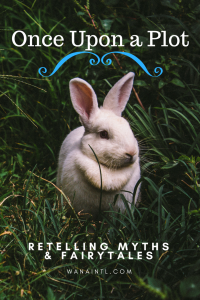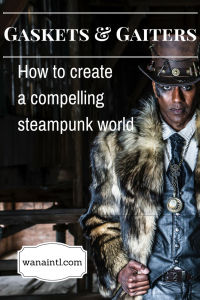OhmygoshitisWednesdayandthatmeansitistimeforMEEEEE!!!!! In other words, it’s Squatter’s Rights Wednesday with me, Cait Reynolds. Today, I’m going to talk about the fact that there is nothing new under the sun.
And, by that, I mean that every variation of story has been told before. Every culture from every time period has its version of Cinderella, its Aladdin or Jack, its greedy kings and tricky old witches. No matter how many magical mice, talking mirrors, or transportation-challenged pumpkins dress up the tale, every story has at its heart the most basic, most fundamental truths about the human condition and human relationships.

Denny Basenji doing his imitation of a wise crone. His cryptic advice to the hero/heroine: “Only peanut butter can help you now.”
Myths and fairytales appeal to our innocence, our belief in justice, and our sense of history. The fact that most of them have happy endings doesn’t hurt, either. The past two years have seen a kind of renaissance in retellings and modern interpretations of these classic stories. A handful have been very well done. The rest have been inconsistent efforts that show very little thought and research has been put into understanding the nature of both mythology and fairytales and how to translate them into contemporary settings.
Celebrity Death Match: Myths vs. Fairytales
So, is there a difference between the two?
Absolutely, and it goes beyond their definitions. But, let’s start with definitions for the sake of clarity.
From merriam-webster.com:
Fairytale:
- a story (as for children) involving fantastic forces and beings (such as fairies, wizards, and goblins)
- a story in which improbable events lead to a happy ending
Myth
- a usually traditional story of ostensibly historical events that serves to unfold part of the world view of a people or explain a practice, belief, or natural phenomenon
- parable, allegory
- a popular belief or tradition that has grown up around something or someone
Here are some other differences between fairytales and myths:
- Myths are not obligated to have a happy ending;
- Fairytales do not have to have a moral or philosophical agenda;
- Myths are often closely tied to world creation stories, religion, and attempts to explain natural phenomenon prior to scientific understanding;
- It is understood that fairytales have never been believed to be real, whereas myths were frequently accepted as fact.
There are more differences and finer distinctions, but I’ll just add in one more. You can always tell it’s a real fairytale because people/animals/magical creatures are cheerful and sing when doing housework.

Research is a Myth…or is it a Fairytale?
Okay, so say we have this great idea retelling ‘Beauty and the Beast.’ We’ve seen the Disney movies, and we are happily humming ‘Be our Guest’ as we open the blank Word document. We know the story cold, and we may or may not have a picture of Luke Evans as Gaston tucked away on Pinterest.
We are ready to start writing. Except, we aren’t.
If all we are doing is using the movie as our guide, we have missed out on the fact that the historical fairytale has variations that include a father who was a merchant, a sudden loss of fortune, two wicked sisters, and a pretty sharp lesson about the costs of indecision and not keeping your word. If we haven’t done any research, we wouldn’t know that the the fairytale actually has origins (at least in Western culture) in the Greek myth of Eros and Psyche, or that another lesser-known fairytale – ‘East of the Sun and West of the Moon’ – spun out from that myth.

It may seem silly to do research on something that is fundamentally untrue and is by nature fluid and adaptable to time period and culture. Yet, without knowing about the people who wrote the stories, the system of beliefs that the myths came from, and the history of the time when a particular variation was recorded, we are losing out on a chance to delve into subtleties, textures, interpretations, and details that take a retelling from blasé to blazing.
One of the topics I cover in my Once Upon a Plot class is how to go about researching a myth or fairytale, what to pursue, what to set aside, and how to analyze the story in a more complex, contextual way.
World-Building for ‘Then’ and ‘Now’
When we do a retelling, one of the first things we have to decide is the setting. Will it be contemporary? Will it be historical? Will it be futuristic, steampunk, or some medieval-ish time?
This impacts what characters we decide to use, the deeper intricacies and devices of the plot, and the way we represent significant objects from the myth or fairytale (is that a pumpkin or a Porsche?). This is also, sadly, where most writers tend to take short-cuts. They use the generic ‘faux-medieval’ setting that is a haphazard mishmash of culture, technology, and clothing, or they set the tale in today’s world, not really thinking through the implications for characters, decisions, and objects.
A lot of writers use the ‘timeless’ setting in order to avoid doing historical research or any real world-building. Ideas for behavior, costumes, servants, food, castles come from whatever historical drama is on at the time (I’m looking at you, ‘Reign,’ ‘The Tudors,’ ‘The White Queen,’ and ‘The Borgias’). While those medieval-renaissance-ish shows do provide a lot of striking visuals and demonstrate how to make archaic-sounding dialogue accessible to modern listeners/readers, they are NOT to be used for world-building. Ever.
Even for fairytales and myths.
As writers, we are responsible for creating our own worlds, and it is our obligation to the reader to provide a setting that is detailed, well thought-out, and consistent.
Here are just a few of the questions writers should ask when picking a ‘timeless’ setting:
- What is the level of technology, industry, medicine, and transportation?
- What is the political structure of the ‘kingdom’?
- What kind of social mobility or stratification exists within the ‘kingdom’?
- What is the kingdom’s primary religion? Are there secondary religions? Competing or conflicting faiths? Holidays and celebrations?
- What is the geography, geology, and climate?
- What is the overall cultural feel (i.e. generic British, generic Scandinavian, generic Central European, generic Mediterranean?)
That’s just the tip of the iceberg for a timeless setting. If we choose a contemporary setting, that brings a whole other set of issues into consideration, including normalizing any magical abilities within a greater social context, secrets vs. open practices, modern equivalents of historical objects or accessories, and how to maintain a character’s original attitude, purpose, and decisions while grounding him or her realistically in the here-and-now.
Bibbity Bobbity BOOYAH
You guessed it. I’m teaching a class on this very topic. All the details below!
 Once Upon a Plot: Retelling Myths & Fairytales
Once Upon a Plot: Retelling Myths & Fairytales
Instructor: Cait Reynolds
Price: $45 USD Standard
Where: W.A.N.A. Digital Classroom
When: WEDNESDAY, August 9, 2017, 7:00 p.m. EST – 9:00 p.m. EST
Myths and fairytales are as fundamental to human existence as communication itself. We grow up hearing these stories, being formed by them, and often rebelling against them.
One of the hottest trends in publishing right now is bringing these stories back and giving them new life with creative interpretations and retellings. Done right, a retelling can capture the public imagination, give us new insights into our society and ourselves, and sweep us away to a time and place where everything, including justice and happy endings, is possible.
Done wrong? A retelling is nothing more than a yawn-worthy yarn full of two-dimensional characters floundering through an unremarkable story with a bland, generic setting.
This class will cover a wide range of topics, including:
- How to research a myth or fairytale, from origins to variations;
- How to analyze in order to develop a deeper, richer understanding of the stories;
- How to pick out the key elements, from characters and attitudes, to objects and settings;
- Creating contemporary settings for retellings that are accurate, believable, and flexible enough to accommodate ‘magic’;
- Creating ‘timeless’ settings that are unique, consistent, and immersive.
A recording of this class is also included with purchase.
GOLD PACKAGE
You get the class (recording included in price) with Cait plus one hour of personalized one-on-one consulting regarding YOUR story.
PLATINUM PACKAGE
You get the class (recording included in price) with Cait plus two hours of personalized one-on-one consulting regarding YOUR story and bonus worksheets. These worksheets will efficiently guide you through in-depth world-building and research, providing you with consistency for your writing and an excellent reference/style sheet for your editor and proofreader.
About the Instructor
 Cait Reynolds is a USA Today Bestselling Author and lives in the Boston area with her husband and four-legged fur child. She discovered her passion for writing early and has bugged her family and friends with it ever since. When she isn’t cooking, running, rock climbing, or enjoying the rooftop deck that brings her closer to the stars, she writes.
Cait Reynolds is a USA Today Bestselling Author and lives in the Boston area with her husband and four-legged fur child. She discovered her passion for writing early and has bugged her family and friends with it ever since. When she isn’t cooking, running, rock climbing, or enjoying the rooftop deck that brings her closer to the stars, she writes.
****And MAKE SURE to check out the classes below and sign up! Summer school! YAY! We’ve added in classes on erotica/high heat romance, fantasy, how to write strong female characters and MORE! So scroll down and sign up!












30 comments
Skip to comment form
Nice to say hello, Cait. Your Post is very informative! Your upcoming Class sounds exciting! Question regarding the Gold or Platinum options. I don’t have a Story that I am writing in this genre. Could the Consultation time be used toward helping me to start? Thanks for your time. Mary
Author
Absolutely! I’d love to work with you on that!
That’s Great. Thank you. Mary
Cait I made a mistake. I wanted to sign up for your Once Upon a Plot and instead signed up for this Friday’s Class about Science Fiction. Can anything be done to change this? Thanks Mary
Author
I believe so! I’ll check with Kristen!
Thank you. I hope so. Sorry for any inconvenience.
Author
You’ve been refunded! You can go ahead and register again 😀
Hi Cait. Thanks. I did re-register. Just like to let you know that the 125.00 is not showing up as refunded. The charge is still in my credit card’s pending category. I’ll keep an eye on this and let you know. When you or Kristen refunded did you send the refund notice transaction to the credit card co? Thanks
Author
Hi Mary,
It can take up to 24 hours for the credit card co to receive and process a refund. If you don’t have it back by tomorrow night, let me know! Cait
Remember; once you take a myth or fairy tale or legend and make it yours, you can shape it however you want. And offend peoples sensibilities. Take mid-summer’s night dream, what if the fairies were evil bastards who only felt the pain they inflected on humans. Or the three witches in Macbeth were the good guys and tried to save everyone. Some authors have already done this.
Yes, I loved what WYRD SISTERS did with that(and the companion book to it that shows what became of the elves was THE SHEPHERD’S CROWN), both by Terry Pratchett.
I hit that spot in ‘Shepard’s Crown’ that caused me to stop reading because–well, I’m sure you know what I’m referring to. It took me a long time to accept what happened and get back to the story. It was worse than the reality of what happened.
But Sir Terry taught me a lot about writing and world building. He gave me hope as a ‘seat of my pants’ writer when I was struggling with the whole plotting/outlining method. And it has worked fine for me. To ‘steal’ from another famous author; soon, my precious. Soon.’
I’ve always wondered if there was a market for re-telling fairy tales with a different perspective. I enjoyed the film “Maleficent” but I know it was harshly criticized because it changed the story so radically.
But what if one could continue the story? What if you wrote about Cinderella becoming queen, and get very “Game of Thrones” on th4e story. Out of mercy, she invites her step mother and wicked sisters to live at the palace. She become pregnant, and the step mother poisons her so that she has a miscarriage. Cinderella survives, but she can no longer have children. She discovers it was her step mother who did gave her the poison, and orders her step sisters tortured to death while their mother watches. The mother is then banished. She walks into the dark forest, where she meets a old hag that offers her a chance at revenge…for a price.
That would be a good story.
This reminds me of a bit from Terry Pratchett’s Hogfather. “…most people forgot that the very oldest stories are, sooner or later, about blood. Later on they took the blood out to make the stories more acceptable to children, or at least to the people who had to read them to children rather than children themselves (who, on the whole, are quite keen on blood provided it’s being shed by the deserving*)… *That is to say, those who deserve to shed blood. Or possibly not. You never quite know with some kids.”
I love this quote 😀
This is such a great post – and timely for me! I’m a contributor to an anthology of retold fairytales that’s coming out in September by NZ & Ozzie-based authors, ‘Wish Upon a Southern Star’… It seems there are retellings and reinterpretations around every corner at the moment, and it’s interesting to consider the ingredients for success. My favourite retelling is Neil Gaiman’s ‘Snow, Glass, Apples’. I’ve signed up for the world building class – again, incredibly timely for me, as I’m sitting on the first draft of a fantasy trilogy and need shifting into revision mode to get myself to the next draft.
Loved the info-graphic on Zeus. Too freakin’ true!
Author
Right?
Great post, Cait! Fun graphics! Thanks for sharing 🙂
Author
Thank you!!!
Hi, I can never attend these classes because of the item difference – I’m in Australia.
Our writing group runs a local annual comp to write a modern myth, legend, folk tale or fairy tale – (dedicated to the memory of one of our late members, who was an Irish storyteller).
The entries are often original, clever and quirky and a joy to hear or read. It’s also fun writing these as they require the imagination to be stretched. Interestingly, the fairy tales we heard as children were sanitised by the Victorians, eg the wicked stepmother in many tales was originally the mother, but this offended the sensibilities of the Victorians. (Of course Disney tales are even more sanitised). As a child I enjoyed reading many fairy and folk tales, including Arabic and Norse, which are often quite violent. My favourite fairy tale is still The Princess and the Goblin, and I have my original book, which is about 60 years old. Worth reading!
Sweet talk Cait into a Friday morning or Saturday morning class here and that should remedy that 😀
Also remember you get the recordings for free with the class, so there is that as well 🙂 .
Author
Hi Anne! I’d love to talk to you about offering my class at a time that could work for you and maybe even your group!
Thank you, I will ask them.
Loved the cards, the graph (does it mean it’s time to stop typing when you can’t remember how to spell ‘graph’?), the whole Zeus thang, and all the tips. I bet the class is wonderful!
Some of the things mentioned about research and world-building reminded me of the historical fiction authors I work with…who are all detail freak/geeks…but their books make it easy to get immersed in the environment. It’s not the detail, it’s knowing enough to make all that stuff seem normal and natural. Like the iconic things/shapes/symbols — we all know Golden Arches and the red Coca-Cola logo — that were known by all in the era of the book.
Thanks, as always, for your humor and insight.
I have a worldbuilding site at http://www.freewebs.com/excessivelyperky – the first page lists all the factors I usually consider while worldbuilding, and the other pages lists the building I did for a fantasy country called Talisgran (currently broken up into big and little provinces). I have categories called Crime and Criminals, Booze, Drugs and Other Fun Things, common diseases, and nascent labor movements. Obviously, it’s not totally complete, but it could be used as a guide for some people.
This one rung quite true with me. One thing I love doing when I write is usimg myths & fairytales, old stories turned them upside down, even jusy borrowing characters and giving them personality, a better background, and perhaps sensibilities from a more modern world even more so than say Lewis Carroll for instance gave Alice in his books. Red riding hood is always interesting as is playing with the bad guy character as ‘Disney did in ‘Maleficent.’ Are bad guys truly as wicked as we think they are? Can they be redeemed? Or did something happen to make them b/co who they are like Gollum in LOTR or even in Malaficent (if she remained evil true to the original Disney version).
https://mandibelle16.wordpress.com/2017/07/29/flash-fiction-for-the-aspiring-writer-open-link-poem-ottava-rima-the-captains-tale-poetry-flashfiction-dverse/
As one that studies mythology and comparative religions (for fun) and a lot of other things related to the human condition I can’t decide if modern religions are myth or fairly tails, both fantastical elements play strongly in religions.I’m leaning toward fairy tales in regard to the big three main monotheistic faith systems. What astounds me is how easily people accept religious tenet as fact. Of course this is good for fiction writers. Readers are pre-wired by inclination and enforced by social indoctrination to suspend disbelief.
Quote:
‘A lot of writers use the ‘timeless’ setting in order to avoid doing historical research or any real world-building. Ideas for behavior, costumes, servants, food, castles come from whatever historical drama is on at the time’
But… but.. but… that’s the FUN PART! Why would anyone skip that? There’s so much to learn out there and it’s so easy now! All we have to do is open up a tab, go to a search and click links. So many links that I get lost in the pages and have to yank myself away. This is my favorite part! In ancient times like in Egit, the Romans, Greeks and most of the other they didn’t have chairs. Especially in Egit would be a rarity and only the rich had them, but even with the rich, they didn’t have many. People sat on benches, sometimes padded benches, and most of the time they sat on the ground on reed mats or in the dirt.
What’s funny is with all that research all that went in was: “Maxwell sat on the padded bench.” Well, at least I got it right.
The real problem could be that do people even stop to think, “Hey did this exist back then?”
My searches look more like: “Aichien Egyptian clothing/furniture/foods/medicine/politics
Then I go check out the Greeks, Romans, Japan, and China (I kind of cherry pick what fits best from what the search finds. If I like something I chase it down. But Mostly I focus on the Egyptians and the ancient Japanese.
When it comes to buildings I like getting inspiration from the ancient Greeks. Okay, that’s getting really long, bye now.